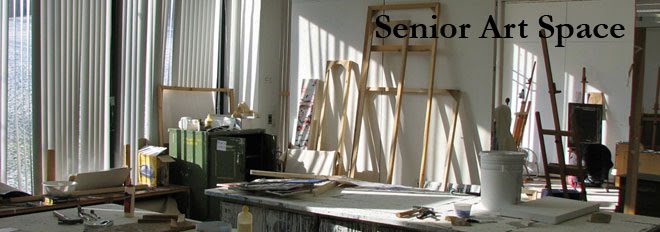Tuesdays 2:00 - 4:40 + HOOCH
PURPOSE
This
portion of the course provides a framework for advanced studio production and
provides you an opportunity to exercise the techniques and cognitive processes
that you will utilize in the future as an artist. It anticipates that you will
maintain and pursue further an evolved understanding of formal and conceptual
considerations, technical facility, and critical discursive ability.
STRUCTURE
Each
class meeting will begin at 2:00 in the Black Room regardless of the class plan.
Scheduled class time will be devoted primarily to production, critiques,
one-to-one meetings and artist presentations; time outside of scheduled periods
will not only be expected and necessary – it will also be scheduled. The
adherence of all safety rules in the shop areas is absolutely imperative; be
accountable to yourself and considerate of others. The maintenance of a clean
studio area is also a shared responsibility. Your presence in the building as a
Studio major comes with added responsibility to the facility and to other
studio students. Access to Sage is a privilege that can be
revoked at the discretion of the faculty or that of the Studio Manager. Work
periods are only that; research and the acquisition of supplies need to happen
outside class. Plan
your meal (should you usually have one planned) before or after class.
Email and texts can be used to relay
information to the instructor and plan in-person appointments; they are not a
substitute for in-person meetings. Turn ‘off’ your cell phones during
class. Strive to communicate clearly - all the time - to everyone - for the
rest of your lives – and let me know when I am not.
Your Hours Outside Of Class Hours (HOOCH) and critiques will be posted.
The latter is tentatively noted in here syllabus; significant changes will be
reflected on the blog. Critiques will take several forms including written. You
should not consider the critiques due dates but opportunities to share your progress,
invite particular sorts of input and mark opportunities for assessment for the
instructor. Brief ad-hoc critiques are likely as well. The Senior Class blog: http://seniorart.blogspot.com/
SUPPLIES
Although
Sage’s basic supplies are available, you will find it convenient or necessary
to supplement these materials. Specific material requests can be made; their
provision is dependent on the availability of funds and whether or not that
material is common enough to be utilized by others.
GRADING
At
this point in your academic career (and life) it is your commitment to art
production and its adjacent concerns that should prompt valuable class
performance, but just in case it isn’t:
|
T
U
E
S
D
A
Y
|
á
|
75% - Art Production - Your
individual works, progress and effort will be evaluated. The ‘quality’ of
work (How carefully you have defined, observed, interpreted, criticized and
crafted your selected topics.) combines with a degree of discipline and a
willingness to broaden one’s self.
25% - Class Participation - How effectively you
contribute to critical discussions and how much you develop and utilize your
skills of persuasion to foster a productive studio for you and your
classmates.
|
More
than two unexcused absences will result in a full grade point drop. Attendance
will be taken during HOOCH and the ‘regular’ class period. HOOCH can be changed
a maximum of two times.
|
A: Excellent work; all work is
presented in a highly professional manner; takes a pro-active role in class
participation.
B: Good work; all work is
presented in a satisfactory manner; takes an active role in class
participation.
C: Average work; all work is
presented in an average manner which does not exhibit attention to detail;
only marginal class participation.
D: Below average work; work is
presented with missing elements or a blatant lack of attention to detail;
minimal class participation.
E: Failure to turn in work; failure to participate in class.
|
This
three-part project is your singular production assignment this semester; all
other work will be initiated independently and in consultation with the
instructors:
(re)work a. – Select a work that you consider finished and base another work
on it. The reworked piece can represent a conceptual tangent of that work, a
version with a different conclusion or even a restitution of sorts. This is not
an opportunity to finish previously started work but an opportunity to start
(and finish) a new work.
On
September 12th you will each provide a four to eight minute
formalized presentation of (re)work to the class, - focus on your process,
motivation and relationship to the work it references. The in-class critique
will follow the presentations. Both works (or documentation of the initial work)
will be presented during the critique.
respond b. – Critique another’s (re)work assignment in 700 to 1000 written
words. Works will be assigned randomly and anonymously. Avoid the reiteration of that said in the
in-class crit and assume that the reader was present for it i.e. no need to describe the work. Within
your assessment be certain to compare your understanding of the work to the
maker’s exposition of it. Email it to Instructor by the end of the day Friday
Sept 15.
reply c. – Reply to the written assessment of your work in the
manner you deem most appropriate. Your reaction to the critique can take any
form; (Remember, temper tantrums are not productive.) reactions may include a
complete start-over, reconsideration of presentation or no physical alteration
at all.*

No comments:
Post a Comment